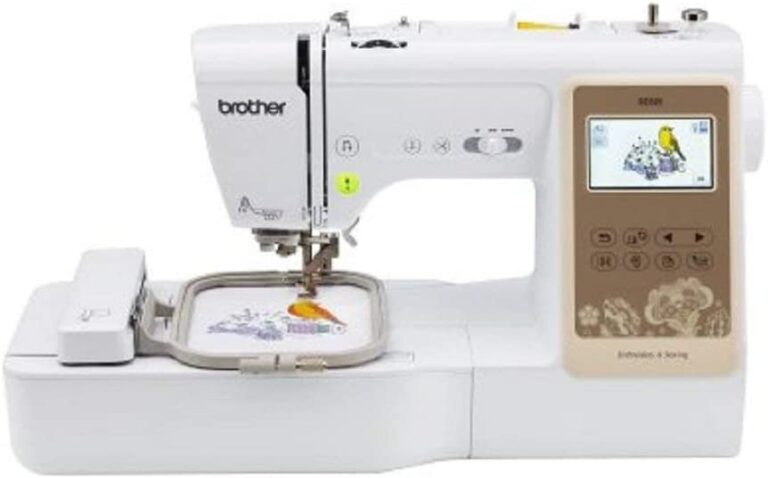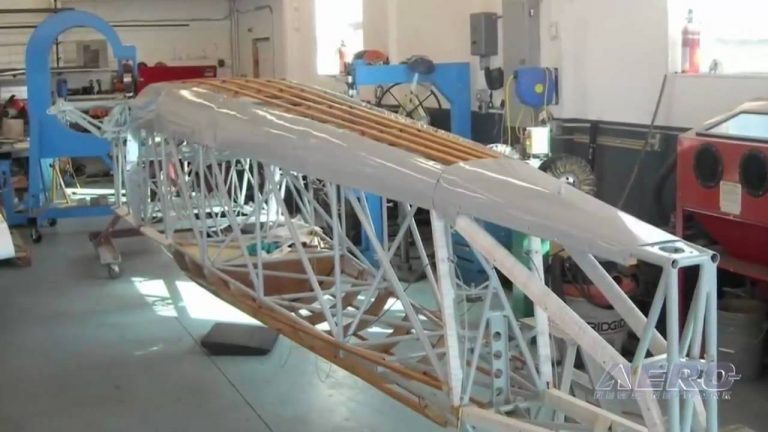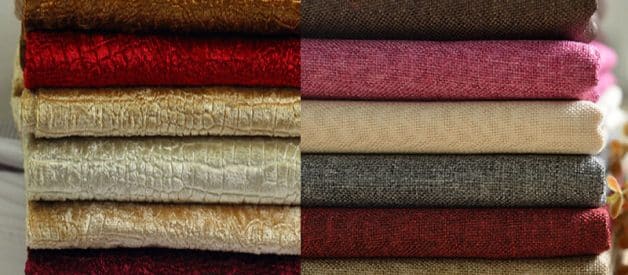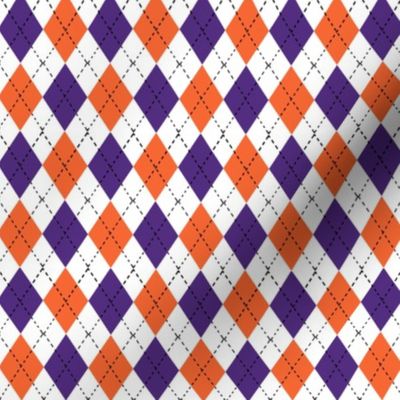Best Sewing Machine for Kids: Top Picks for Young Crafters
Table of Contents
- 1 Top Sewing Machines for Kids
- 2 Buying Guide
- 3 Frequently Asked Questions
- 3.1 What features should I look for in a sewing machine suitable for children?
- 3.2 At what age can a child start learning how to sew with a machine?
- 3.3 Are there specific sewing machine models that are recommended for young beginners?
- 3.4 What safety precautions should be considered when purchasing a sewing machine for a child?
- 3.5 How do I choose a sewing machine that will grow with my child’s skills?
- 3.6 What are the benefits of teaching a child to sew with a real sewing machine versus a toy version?
Top Sewing Machines for Kids
Finding the right sewing machine for our youngsters can spark a lifelong passion for crafting and creativity. We’ve gathered some of the best sewing machines that are kid-friendly, combining safety features with ease of use. Our selection ensures that you’ll find a suitable option for your little tailor or seamstress to begin their sewing journey.
BEST CHOICE: HJWTCQL Mini Marvel

We think this machine is fantastic for young sewing enthusiasts, offering convenience and simplicity for their creative projects.
Pros
- Delightfully lightweight and portable for on-the-go crafts
- Beginner-friendly features and safety measures that inspire confidence
- Dual power modes add flexibility to sewing sessions anywhere
Cons
- Some parts may feel flimsy, requiring a gentle hand
- The petite size might limit the scope of projects
- Advanced sewers could find the feature set limiting
We’ve just tried out the HJWTCQL Mini Marvel, and it’s as adorable as it is functional. Its lightweight design has made it a breeze to move around—perfect for the little ones who might want to take their sewing hobby from their room to a friend’s house or even a sewing class.
The 12 built-in stitches have impressed us and the reverse stitching function is a thoughtful touch that’s not always found in kid-friendly machines. Compared to some dauntingly complex machines we’ve seen, this one simplifies the sewing process, which is ideal for keeping kids engaged and not overwhelmed.
Having options to power it up with batteries or an AC adapter is terrific for those afternoons in the backyard where an electric outlet may not be within reach. But while we gave it a spin, we noticed that some parts felt a bit delicate. Handling it with care is a must, especially when guiding eager young sewers in their first sewing ventures.
What’s been truly valuable is that the threading guide is printed right on the body of the machine—no squinting at tiny manuals or getting tutorial headaches. The sewing light is a practical feature; it’s made those darker fabrics a lot less frustrating for us to work on.
On the downside, its compact nature does mean that ambitious projects might have to be shelved for a bigger machine. Advanced users might outgrow this model quickly, craving more stitch varieties and power. But for beginners and especially kids, we see the HJWTCQL Mini Marvel as a welcoming introduction to the world of sewing.
BEST STARTER: Magicfly Mini Sewing Machine

We found that this machine is a delightful starting point for the young sewing enthusiasts in your life, offering ease and portability.
Pros
- Highly Portable
- User-Friendly Setup
- Accessory Kit Included
Cons
- Not Suitable for Thick Fabrics
- May Jam with Heavy Use
- Limited Stitching Options
After having the pleasure of threading the Magicfly Mini Sewing Machine, we were charmed by its lightweight design; it’s as warm and hassle-free as attending a community sewing circle. This pink wonder doesn’t just sit prettily; it’s portable enough to transport from room to room, mimicking the movements of those constantly on the go.
The playfulness of this machine lies in its simplicity. Specifically engineered for beginners and children, it makes the complex art of sewing accessible. We noticed the clearly marked threading directions, a blessing for little fingers or those of us with less nimble hands.
Supplementing this machine’s capability is the practical sewing kit that accompanies it. We laid out bobbins, needles, and other accessories on our crafting table, and the extension table elevated our comfort during larger projects. It’s like having an extra hand to hold the fabric steady.
However, patience must be your virtue while using this machine. It isn’t built to withstand the demands of thick fabrics or prolonged sewing sessions. And while its single stitch type may limit creativity, it’s precisely what keeps the sewing process uncomplicated for the younger crowd.
Despite its few limitations, we believe the Magicfly Mini Sewing Machine forges a foundational step into the stitching world. Its friendliness toward beginners is its strongest thread, ensuring that fledgling skills are nurtured rather than knotted.
BEST BEGINNER: Marinette’s Mini Sewing Machine
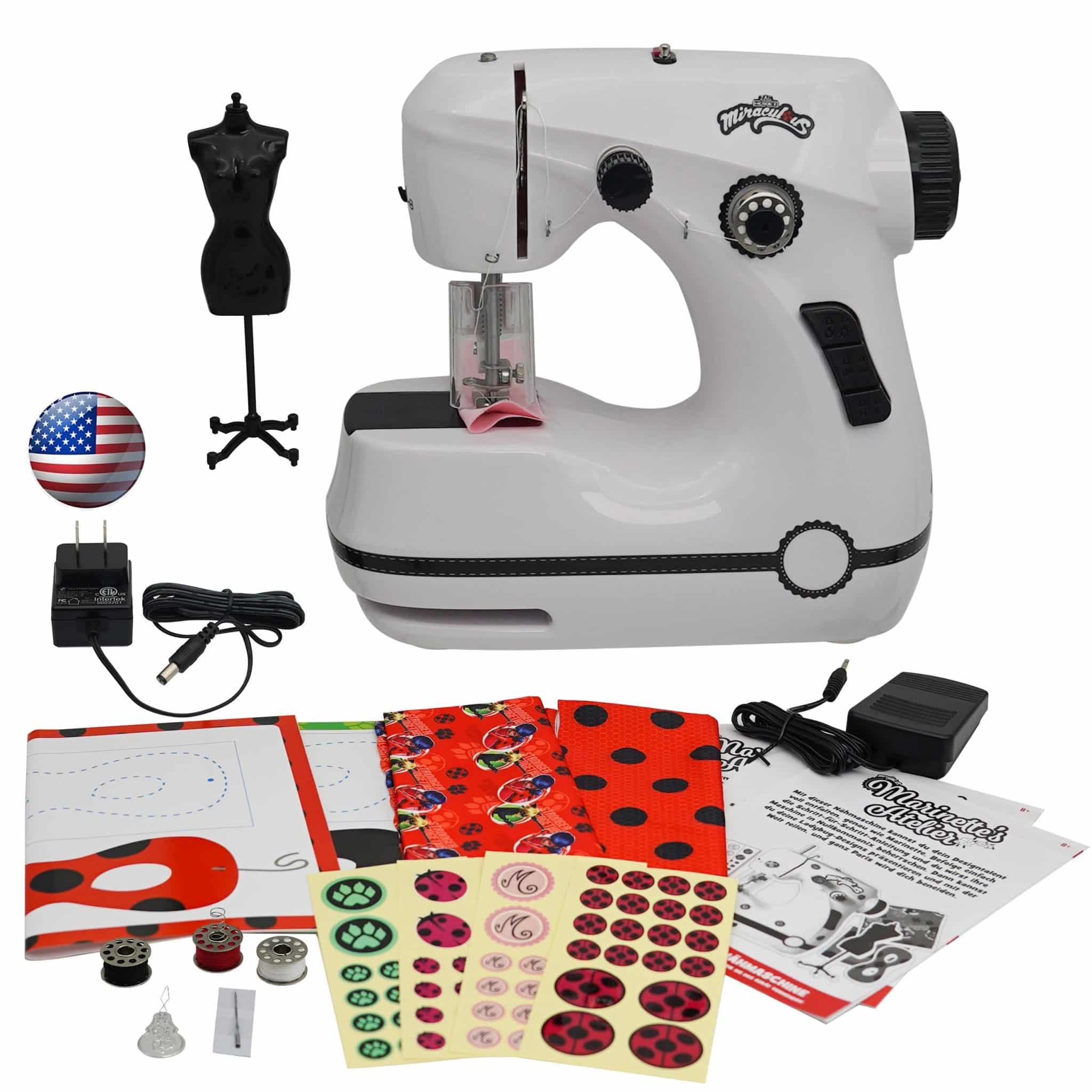
We just had the most delightful time using the Marinette’s Mini Sewing Machine and it’s a charming choice for your young designer’s first stitches.
Pros
- Safe and kid-friendly with a finger guard and protective needle cover.
- Easy to start with battery operation option and foot pedal control.
- Adorable customizations with themed stickers to make the machine their own.
Cons
- Not as proficient for larger sewing projects.
- Batteries not included, which might interrupt the sewing experience.
- The noise level might be bothersome for some users.
Our young enthusiasts found it incredibly exciting to embark on a sewing project with Marinette’s Mini Sewing Machine. The sense of accomplishment they feel when they finish their first piece is immeasurable. Our latest creation involved stitching together a simple fabric mask, and the machine’s dual speed settings meant we could take it slow, ensuring our fingers stayed well clear of the needle thanks to the thoughtful safety features.
The aesthetics were a hit too. We took our time adorning the machine with stickers, making it feel like a personal treasure right out of Miraculous. It wasn’t just about the sewing; it was about building an experience, an adventure in every stitch – a real bonding activity.
Despite its smaller size, this little gadget packed quite a surprise. We navigated through layers of fabric with surprising ease. To be fair, when we tried to tackle a thicker material, the machine did struggle a bit. But for all the crafting and small projects we’ve got our hearts set on, it’s more than up to the task. If you find yourself needing something for more demanding sewing projects, you might want to consider a larger, more powerful machine.
But for us, we cherish the laughter, the lightbulb moments when a new skill is learned, and the pride in our children’s eyes as they hold up their sewn-together creations. The Marinette’s Mini Sewing Machine has certainly sewn its way into our hearts, noise and all.
BEST FOR SMALL CRAFTS: My Very Own Sewing Machine

We think this sewing machine is a charming starter for kids who are eager to learn sewing, with its user-friendly features and child-safe design.
Pros
- Delightfully straightforward for the little ones to begin sewing projects immediately.
- The safety features provide peace of mind for us parents.
- It comes with several creative project ideas to keep the interest alive.
Cons
- Durability may be questionable with frequent use.
- Limited functionality compared to more advanced machines.
- The included instructions could be clearer for a complete novice.
When we got our hands on the ‘My Very Own Sewing Machine’, we were thrilled by its compact and vibrant design. It’s just the right size for smaller hands, and having it battery-powered meant we could take our sewing adventures anywhere without worrying about finding a power outlet. What a joy to see the kids’ eyes light up as they stitched their first lines!
Adjusting the settings was a breeze, and the pre-threaded bobbins were a nice touch, allowing us to dive right into sewing without any intimidating setup. There’s something truly rewarding about witnessing the confidence grow in young ones as they navigate through the initial learning curve of new stitches and seams.
While the construction is sturdy enough, we did notice that it might not hold up to the rigors of a zealous seamster’s ambitions over time. But, for the price and the amount of joy it brings to children, it’s a trade-off we’re willing to make. After all, nurturing creativity is worth the world.
Buying Guide
Safety Features
As we’re selecting a sewing machine for kids, safety is our top priority. We want to look for models with finger guards to prevent any accidental nicks or pokes. Some machines also offer a start/stop button which means there’s no foot pedal to worry about — a great feature for beginner coordination.
Ease of Use
Our young sewers need machines that are straightforward. Large threading diagrams, easy-to-use controls, and even automatic threading can make their sewing experience enjoyable and less frustrating. Simplicity is key here!
Durability and Maintenance
Children’s machines should be durable but not overly complex. We’re looking for a machine that can handle the occasional drop and yet remain easy to maintain. Avoid machines with lots of external parts that can easily snap off.
Appropriate Size
The size of the sewing machine should be suitable for smaller hands and bodies. Compact and lightweight are our go-to words here, ensuring the machine can be moved and handled by our young crafters.
Functionalities
Consider the types of sewing projects they’ll embark on. Basic machines with straight and zigzag stitches meet most needs. However, if we’re fostering a budding fashion designer, a machine with a few more stitch options could be beneficial.
| Features to Consider | Notes |
|---|---|
| Safety Mechanisms | Look for finger guards and no foot pedal options |
| Simplicity | Easy threading, simple controls |
| Durability | Can withstand drops, easy to clean |
| Size and Weight | Small, lightweight and portable |
| Stitch Options | Basic stitches with optional extras |
Remember, the goal is to encourage their interest in sewing with a machine that’s both functional and accessible for their skill level. Let’s choose wisely to craft a delightful sewing experience for our young ones.
Frequently Asked Questions
When picking the perfect sewing machine for our little ones, we want features that are safe and user-friendly, suitable for their age, and versatile enough to keep up with their growing creativity. Let’s address some common queries to help us make informed decisions.
What features should I look for in a sewing machine suitable for children?
We should seek out sewing machines with simple interfaces, durable design, and safety features such as finger guards. Additionally, adjustable speed controls are excellent for helping kids learn at a comfortable pace.
At what age can a child start learning how to sew with a machine?
Children as young as six years old can begin learning to sew under supervision, focusing on machines that are designed for their age group and skill level.
Are there specific sewing machine models that are recommended for young beginners?
Yes, certain models like the Janome Fastlane and Brother XM2701 are well-regarded as starter machines for kids due to their ease of use and appropriate size.
What safety precautions should be considered when purchasing a sewing machine for a child?
Key safety features include a finger guard, no exposed parts that could catch little fingers, speed control for safer operation, and making sure the machine is stable and not easily tipped over.
How do I choose a sewing machine that will grow with my child’s skills?
Select a machine with a variety of basic to intermediate functions, such as adjustable stitch lengths and widths, different foot attachments, and perhaps a selection of basic stitches.
What are the benefits of teaching a child to sew with a real sewing machine versus a toy version?
Sewing with a real machine helps children develop fine motor skills, patience, and an understanding of garment construction, while toy versions may not offer the same level of practical experience or longevity.



